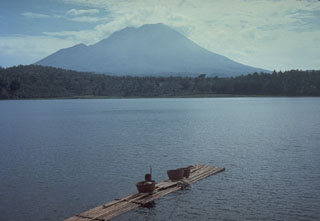Report on Lamongan (Indonesia) — February 2012
Bulletin of the Global Volcanism Network, vol. 37, no. 2 (February 2012)
Managing Editor: Richard Wunderman.
Lamongan (Indonesia) Steep increase in seismicity during February-March 2012
Please cite this report as:
Global Volcanism Program, 2012. Report on Lamongan (Indonesia) (Wunderman, R., ed.). Bulletin of the Global Volcanism Network, 37:2. Smithsonian Institution. https://doi.org/10.5479/si.GVP.BGVN201202-263320
Lamongan
Indonesia
7.981°S, 113.341°E; summit elev. 1641 m
All times are local (unless otherwise noted)
According to the Center of Volcanology and Geological Hazard Mitigation (CVGHM), Lamongan has not erupted since 1898. On several occasions since then, however, seismic activity has increased. Brief periods of earthquakes and earthquake swarms occurred in 1924-25, 1978, 1985, and 1988 (SEAN 10:10, 10:11, 13:02). The Darwin Volcanic Ash Advisory Centre (VAAC) reported on 24 September 2003 that aircraft personnel had observed ash over the volcano to a height of about 900 m, but this was not confirmed by on-scene observers (BGVN 28:12). Our previous report noted continuous tremor and an earthquake swarm on 5-6 January 2005 (BGVN 31:01).
CVGHM reported that during 1 February-9 March 2012, diffuse white plumes rose at most 20 m above Lamongan's crater. Seismicity increased on 23 February, then fluctuated in intensity through 7 March. Seismicity increased significantly on 8-9 March (table 1). CVGHM raised the Alert Level to 2 (on a scale of 1-4) on 9 March, and began to monitor the volcano more intensively. Residents and tourists were prohibited from going within a 1-km-radius of the active crater. No eruptions occurred during the reporting period. Increased seismic activity at Lamongan continued at least through 12 March.
Table 1. Seismicity at Lamongan during 1 January-9 March 2012. Data from CVGHM. Shallow volcanic earthquakes were not reported and categories were not defined in the reports.
| Date (2012) | Deep Volcanic | Distant Tectonic | Local Tectonic |
| January | 2 | 16 | -- |
| 1-22 February | 1 | 15 | na |
| 23-29 February | 69 | 7 | 1 |
| 1-7 March | 77 | 6 | 7 |
| 8 March (0000-1200 hours) | 135 | -- | -- |
| 9 March (0000-1100 hours, continuous tremor) | -- | -- | 131 |
Geological Summary. Lamongan, a small stratovolcano located between the massive Tengger and Iyang-Argapura volcanic complexes, is surrounded by numerous maars and cinder cones. The currently active cone has been constructed 650 m SW of Gunung Tarub, the volcano's high point. As many as 27 maars with diameters from 150 to 700 m, some containing crater lakes, surround the volcano, along with about 60 cinder cones and spatter cones. Lake-filled maars, including Ranu Pakis, Ranu Klakah, and Ranu Bedali, are located on the E and W flanks; dry maars are predominately located on the N flanks. None of the maars has erupted during historical time, although several of the youthful maars cut drainage channels from Gunung Tarub. The volcano was very active from the time of its first historical eruption in 1799 through the end of the 19th century, producing frequent explosive eruptions and lava flows from vents on the western side ranging from the summit to about 450 m elevation.
Information Contacts: Center of Volcanology and Geological Hazard Mitigation (CVGHM), Jalan Diponegoro 57, Bandung 40122, Indonesia (URL: http://www.vsi.esdm.go.id/); Darwin Volcanic Ash Advisory Centre (VAAC), Bureau of Meteorology, Northern Territory Regional Office, PO Box 40050, Casuarina, NT 0811, Australia (URL: http://www.bom.gov.au/info/vaac/).

